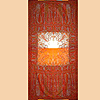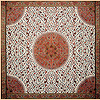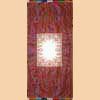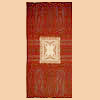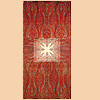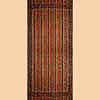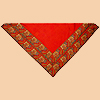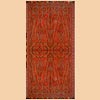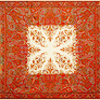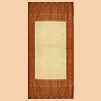 A Rare Masterpiece of Early Franch Shawl
A Rare Masterpiece of Early Franch Shawl

History of Jacquard's loom
The first industrial application of a (semi)-automated machine was made in the early eighteenth century by a modest textile worker from Lyon, France.
Basile Bouchon, working in one of the many silk centers in Lyon, invented a way to control a loom with a perforated paper tape. Bouchon was the son of an organ maker and a weaver and was familiar with the fact that the information content for the cylinders of musical automata was first laid-out on paper, before the design was applied to actual very expensive cylinders. The practice then was to punch holes in the paper designs that were wrapped around the cylinders, indicating where the craftsman had to drill holes in the cylinder for the pegs. Bouchon probably had the brilliant insight that the paper layout with punched holes already contained the information put on the cylinder, thus he concluded that perforated paper could code information about patterns, which he subsequently applied to the coding of weaving patterns for the loom.
Thus Bouchon adapted the concept of music automata controlled by pegged cylinders to the repetitive task of weaving and partially automated the tedious setting up process of the draw loom in which an operator lifted the warp threads using cords, inventing an attachment for the looms, which used a broad strip of punched paper to select the warp threads that would be raised during weaving.
Bouchon's invention involved a row of hooks. The curved portion of each hook snagged a string that could raise one of the warp threads, whereas the straight portion of each hook pressed against the punched paper, which was draped around a perforated cylinder. Whenever the hook pressed against the solid paper, pushing the cylinder forward would raise the corresponding warp thread, but when the hook met a hole in the paper, pushing the cylinder forward would allow the hook to slip inside the cylinder and the corresponding warp thread would not be raised.
In spite of its advantages, Bouchon's invention did not have much success because the number of needles was not sufficient to allow the weaving of large designs. Besides that, he used a roll of paper (see the image nearby), which was not very practical.
Only three years later, in 1728, one of the Bouchon's assistants, named Jean-Baptiste Falcon improved on the machine, expanding the number of cords that could be handled by arranging the holes in rows. He also replaced the paper roll with a set of punched cards attached to one another in an endless loop (see the nearby image), which made it possible to change the program rapidly. Each punch card controlled a single hook or needle. Falcon's system was superior because torn cards could easily be replaced whereas Bouchon's system required whole rolls to be reproduced if one tear made a roll unusable.
Though the looms of Bouchon and Falcon eliminated mistakes in the lifting of threads, they still needed an extra operator (or even two of them) to operate. The loom of Bouchon and Falcon was modestly successful: about 40 such looms had been sold by 1762. The first attempt at full automation was made by Jacques Vaucanson in 1745 also not very successful. But it was not until 1805 that the wildly successful Jacquard Loom was finally produced.
A reconstruction of the Basile Bouchon's loom (© CNAM, Paris)
Joseph-Marie Jacquard
Joseph-Marie Jacquard was not the inventor of the programmable loom, as many people imagine, actually he created an attachment to the loom, which played a very important role not only in the textile industry, but also in development of other programmable machines, such as computers, for example the Analytical Engine of Charles Babbage.
Joseph-Marie Charles (known as Jacquard after the nickname of his family) was born on 7th of July 1752 in Lyon, France. He was the fifth of nine children of Jean Charles (nicknamed Jacquard) (1724-1772) a master weaver of brocaded fabrics, and his wife, Antoinette Rive. From the nine children, only Joseph and his sister Clémence (born 1747) survived to adulthood. Like the sons of many Lyons weavers, Joseph did not go to school, because his father needed him to perform odd jobs in the workshop. He learned to read as a thirteen-year-old boy by his brother-in-law Barret, a cultured man.
Antoinette Rive died in 1762, and after his end the family slid into poverty. Surprisingly, when Jean Charles died in 1772 Joseph inherited more assets than anyone expected: his father's apartment, the workshop with two looms, as well as some other real estate. In 1778 he listed his occupations as master weaver and silk merchant. In the same year he married the rich widow Claudine Boichon. Their only son Jean-Marie, was born in April, 1779. In the next few years however, Joseph took part in a number of dubious entrepreneurial investments and soon fell deeply into debt and was brought to court, loosing his inheritance and part of his wife's property. So in 1783 he slid again into poverty. Claudine stayed with their son in Lyon, working in a straw-hat factory, while Joseph tried his luck in other places as a lime-burner, a labourer in a plaster quarry, etc. before to return in Lyon in the end of 1780s.
In 1793 Joseph-Marie and his son took part in the unsuccessful defense of Lyon against the troops of the Convention, and when the city fell, the two fled together, then adopted false names and joined the Revolutionary army. After seeing some active service, in 1797 Jean-Marie was shot down in a battle, and Joseph-Marie Jacquard returned to Lyon in 1798, lost again the plot of his life. After a stay in the hospital, he worked at various odd jobs repairing looms, weaving, bleaching straw hats, driving horse-drawn carts, etc. It was probably in 1799, when he decided to dabble in automation of weaving, an occupation, which will made his name unforgettable.
In July 1800 Joseph Jacquard applied for his first patent a treadle loom, then a loom to weave fishing nets in 1803, and starting in 1804, the Jacquard loom, which would weave patterned silk automatically. First looms of Jacquard were unsuccessful however, not only because were not operating well, but also for strong opposition by the silk-weavers. When in 1801, after a successful exposition in Paris, Jacquard exhibited his first loom in Lyon, the weavers, thinking their bread and butter endangered by the new machine, mobbed the inventor and broke up his invention. Jacquard describes the occurrence himself. The iron was sold for old iron, the wood for fuel, while I was delivered over to universal ignominy.
It is out of the question, that Jacquard was informed about the earlier attempts of his fellow-citizens Basile Bouchon Jean Falcon and Jacques Vaucanson to create an automated loom. After his not very successful first looms, the breaktrough came in 1803, when at the urging of a Lyon silk merchant, Jacquard went to Paris and visited the Conservatoire des Arts et Metiers. There he examined the loom of Jacques de Vaucanson and suggested various improvements in his own, which he gradually perfected to its final state.
One of the first improvements of Jacquard was to eliminate the paper strip from Vaucanson's mechanism and to return to Falcon's chain of punched cards. Then, he tried to avoid the expensive metal cylinders of Vaucanson. In fact, the term Jacquard loom is a misnomer, actually Jacquard's invented an attachment (head), that adapts to a great many type of looms, that allow the weaving machine to create the intricate patterns often seen in Jacquard weaving. Thus any loom that uses the attachment is called a Jacquard loom.
Each position in the punched card of the loom corresponds to a hook, which can either be raised or stopped dependant on whether the hole is punched out of the card or the card is solid. The hook raises or lowers the harness, which carries and guides the warp thread so that the weft will either lie above or below it. The sequence of raised and lowered threads is what creates the pattern. Each hook can be connected via the harness to a number of threads, allowing more than one repeat of a pattern. For example, a loom with a 500-hook head might have four threads connected to each hook, resulting in a fabric that is 2000 warp ends wide with four repeats of the weave going across.
An old Jacquard loom
In April 1805 emperor Napoleon and empress Josephine visited Lyon, and during their tour, they viewed Jacquard's new loom and granted the patent for Jacquard's loom to the city of Lyon. In return, Jacquard received a lifelong pension of 3000 francs, a huge sum for the time. Moreover, he received a royalty of 50 francs for each loom that was bought and used during the period of six years. This was a generous attitude towards the inventor and made him rich. By 1812 there were some 11000 Jacquard looms in use in France and despite energetic French efforts to keep the technology secret, they were also beginning to appear in other countries.
Joseph Marie Jacquard died at Oullins (Rhône) on 7th of August, 1834.
The modern Jacquard looms are using image scanners, allowing any visual image to be woven to be inputted into the loom. The scanner, in turn, is linked to a computer, that converts the image into pixels in a program, which is used to control the hooks that lift the correct warp threads to form the image during the weaving process.
